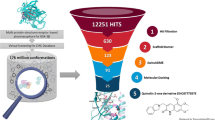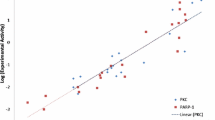Abstract
Myo-inositol-1-phosphate (MIP) synthase is a key enzyme in the myo-inositol biosynthesis pathway. Disruption of the inositol signaling pathway is associated with bipolar disorders. Previous work suggested that MIP synthase could be an attractive target for the development of anti-bipolar drugs. Inhibition of this enzyme could possibly help in reducing the risk of a disease in patients. With this objective, three dimensional structure of the protein was modeled followed by the active site prediction. For the first time, computational studies were carried out to obtain structural insights into the interactive behavior of this enzyme with ligands. Virtual screening was carried out using FILTER, ROCS and EON modules of the OpenEye scientific software. Natural products from the ZINC database were used for the screening process. Resulting compounds were docked into active site of the target protein using FRED (Fast Rigid Exhaustive Docking) and GOLD (Genetic Optimization for Ligand Docking) docking programs. The analysis indicated extensive hydrogen bonding network and hydrophobic interactions which play a significant role in ligand binding. Four compounds are shortlisted and their binding assay analysis is underway.






Similar content being viewed by others
References
Harwood AJ (2004) Lithium and bipolar mood disorder: the inositol-depletion hypothesis revisited. Mol Psychiatr 10:117–126
Steger DJ, Haswell ES, Miller AL, Wente SR, O’Shea EK (2003) Regulation of chromatin remodeling by inositol polyphosphates. Sci Signal 299:114–116
Shen X, Xiao H, Ranallo R, Wu WH, Wu C (2003) Modulation of ATP-dependent chromatin-remodeling complexes by inositol polyphosphates. Sci Signal 299:112–114
Vadnal R, Parthasarathy L, Parthasarathy R (1997) Role of inositol in the treatment of psychiatric disorders. CNS Drugs 7:6–16
Ju S, Shaltiel G, Shamir A, Agam G, Greenberg ML (2004) Human 1-d-myo-inositol-3-phosphate synthase is functional in yeast. J Biol Chem 279:21759–21765
Guan G, Dai P, Shechter I (2003) cDNA cloning and gene expression analysis of human myo-inositol 1-phosphate synthase. Arch Biochem Biophys 417:251–259
Tokuoka SM, Saiardi A, Nurrish SJ (2008) The mood stabilizer valproate inhibits both inositol-and diacylglycerol-signaling pathways in Caenorhabditis elegans. Mol Biol Cell 19:2241–2250
O’Donnell T, Rotzinger S, Nakashima TT, Hanstock CC, Ulrich M, Silverstone PH (2000) Chronic lithium and sodium valproate both decrease the concentration of myo-inositol and increase the concentration of inositol monophosphates in rat brain. Brain Res 880:84–91
Shaltiel G, Shamir A, Shapiro J, Ding D, Dalton E, Bialer M, Harwood AJ, Belmaker RH, Greenberg ML, Agam G (2004) Valproate decreases inositol biosynthesis. Biol Psychiatry 56:868–874
JAMA and Archives Journals (2011) Prevalence and severity of bipolar disorder worldwide. ScienceDaily. http://www.sciencedaily.com/releases/2011/03/110307161901.htm. Accessed 8 Apr 2013
Agam G, Shamir A, Shaltiel G, Greenberg ML (2002) Myo-inositol-1-phosphate (MIP) synthase: a possible new target for antibipolar drugs. Bipolar Disord 4:15–20
Nau H, Hauck RS, Ehlers K (2009) Valproic acid-induced neural tube defects in mouse and human: aspects of chirality, alternative drug development, pharmacokinetics and possible mechanisms. Pharmacol Toxicol 69:310–321
Wadzinski J, Franks R, Roane D, Bayard M (2007) Valproate-associated hyperammonemic encephalopathy. J Am Board Fam Med 20:499–502
Sousa SF, Fernandes PA, Ramos MJ (2006) Protein–ligand docking: current status and future challenges. Proteins: Struct Funct Bioinform 65:15–26
Saleem A, Azam SS, Zarina S (2012) Docking and molecular dynamics simulation studies on glycation-induced conformational changes of human paraoxonase 1. Eur Biophys J 41:241–248
Šali A, Potterton L, Yuan F, van Vlijmen H, Karplus M (2004) Evaluation of comparative protein modeling by MODELLER. Proteins: Struct Funct Bioinform 23:318–326
Pieper U, Eswar N, Braberg H, Madhusudhan MS, Davis FP, Stuart AC, Mirkovic N, Rossi A, Marti-Renom MA, Fiser A, Webb B, Greenblatt D, Huang CC, Ferrin TE, Sali A (2004) MODBASE, a database of annotated comparative protein structure models, and associated resources. Nucleic Acids Res 32:D217–D222
Zhang Y (2008) I-TASSER server for protein 3D structure prediction. BMC Bioinformatics 9:40
Lambert C, Léonard N, De Bolle X, Depiereux E (2002) ESyPred3D: prediction of proteins 3D structures. Bioinformatics 18:1250–1256
Schwede T, Kopp J, Guex N, Peitsch MC (2003) SWISS-MODEL: an automated protein homology-modeling server. Nucleic Acids Res 31:3381–3385
Laskowski RA, MacArthur MW, Moss DS, Thornton JM (1993) PROCHECK: a program to check the stereochemical quality of protein structures. J Appl Crystallogr 26:283–291
Pettersen EF, Goddard TD, Huang CC, Couch GS, Greenblatt DM, Meng EC, Ferrin TE (2004) UCSF Chimera—a visualization system for exploratory research and analysis. J Comput Chem 25:1605–1612
Colovos C, Yeates TO (2008) Verification of protein structures: patterns of nonbonded atomic interactions. Protein Sci 2:1511–1519
Eisenberg D, Lüthy R, Bowie JU (1997) VERIFY3D: assessment of protein models with three-dimensional profiles. Methods Enzymol 277:396–404
Wiederstein M, Sippl MJ (2007) ProSA-web: interactive web service for the recognition of errors in three-dimensional structures of proteins. Nucleic Acids Res 35(Suppl 2):W407–W410
Gasteiger E, Hoogland C, Gattiker A, Wilkins MR, Appel RD, Bairoch A (2005) Protein identification and analysis tools on the ExPASy server. In: Walker John M (ed) The proteomics protocols handbook. Humana Press, New York, pp 571–607
Laskowski RA, Watson JD, Thornton JM (2005) ProFunc: a server for predicting protein function from 3D structure. Nucleic Acids Res 33(Suppl 2):W89–W93
Stein AJ, Geiger JH (2002) The crystal structure and mechanism of 1-l-myo-inositol-1-phosphate synthase. J Biol Chem 277:9484–9491
Jin X, Foley KM, Geiger JH (2004) The structure of the 1l-myo-inositol-1-phosphate synthase-NAD+-2-deoxy-d-glucitol 6-(E)-vinylhomophosphonate complex demands a revision of the enzyme mechanism. J Biol Chem 279:13889–13895
Irwin JJ, Shoichet BK (2005) ZINC-a free database of commercially available compounds for virtual screening. J Chem Inf Model 45:177–182
Harvey AL (2008) Natural products in drug discovery. Drug Discov Today 13:894–901
Hawkins PC, Skillman AG, Nicholls A (2007) Comparison of shape-matching and docking as virtual screening tools. J Med Chem 50:74–82
Muchmore SW, Souers AJ, Akritopoulou-Zanze I (2006) The use of three-dimensional shape and electrostatic similarity searching in the identification of a melanin-concentrating hormone receptor 1 antagonist. Chem Biol Drug Des 67:174–176
Fontaine F, Bolton E, Borodina Y, Bryant SH (2007) Fast 3D shape screening of large chemical databases through alignment-recycling. Chem Cent J 1:1–14
Rush TS, Grant JA, Mosyak L, Nicholls A (2005) A shape-based 3-D scaffold hopping method and its application to a bacterial protein–protein interaction. J Med Chem 48:1489–1495
Sangster J (1997) Octanol–water partition coefficients: fundamentals and physical chemistry. Eur J Med Chem 32:842
Hawkins PC, Skillman AG, Warren GL, Ellingson BA, Stahl MT (2010) Conformer generation with OMEGA: algorithm and validation using high quality structures from the Protein Databank and Cambridge Structural Database. J Chem Inf Model 50:572–584
Jergil M, Forsberg M, Salter H, Stockling K, Gustafson AL, Dencker L, Stigson M (2011) Short-time gene expression response to valproic acid and valproic acid analogs in mouse embryonic stem cells. Toxicol Sci 121:328–342
Pessah N, Yagen B, Hen N, Shimshoni JA, Wlodarczyk B, Finnell RH, Bialer M (2011) Design and pharmacological activity of glycinamide and N-methoxy amide derivatives of analogs and constitutional isomers of valproic acid. Epilepsy Behav 22:461–468
Galit S, Shirley M, Ora K, Belmaker RH, Galila A (2007) Effect of valproate derivatives on human brain myo-inositol-1-phosphate (MIP) synthase activity and amphetamine-induced rearing. Pharmacol Rep 59:402–407
Comelli NC, Lobayan RM, Castro EA, Jubert AH (2011) Study of the structural and electronic properties of valproic acid and new derivatives used as anticonvulsant agents. J Phys Chem A 115:1686–1700
McGaughey GB, Sheridan RP, Bayly CI, Culberson JC, Kreatsoulas C, Lindsley S, Maiorov V, Truchon JF, Cornell WD (2007) Comparison of topological, shape, and docking methods in virtual screening. J Chem Inf Model 47:1504–1519
Jones G, Willett P, Glen RC, Leach AR, Taylor R (1997) Development and validation of a genetic algorithm for flexible docking. J Mol Biol 267:727–748
Wallace AC, Laskowski RA, Thornton JM (1995) LIGPLOT: a program to generate schematic diagrams of protein–ligand interactions. Protein Eng 8:127–134
Molecular Operating Environment (MOE), 2012.10; Chemical Computing Group Inc., 1010 Sherbooke St. West, Suite #910, Montreal, QC, Canada, H3A 2R7, 2012
Humphrey W, Dalke A, Schulten K (1996) VMD—Visual Molecular Dynamics. J Mol Graphics 14:33–38
Wang R, Lai L, Wang S (2002) Further development and validation of empirical scoring functions for structure-based binding affinity prediction. J Comput Aid Mol Des 16:11–26
McGann MR, Almond HR, Nicholls A, Grant JA, Brown FK (2002) Gaussian docking functions. Biopolymers 68:76–90
Costakes GT (2006) Overview of current docking programs. MMG 445 Basic Biotech eJ 1:4
Liebeschuetz JW, Cole JC, Korb O (2012) Pose prediction and virtual screening performance of GOLD scoring functions in a standardized test. J Comput Aid Mol Des 26:737–748
Chakrabarti S, Lanczycki CJ (2007) Analysis and prediction of functionally important sites in proteins. Protein Sci 16:4–13
Shanmugam A, Natarajan J (2012) Comparative modeling of UDP-N-acetylmuramoyl-glycyl-d-glutamate-2,6-diaminopimelate ligase from Mycobacterium leprae and analysis of its binding features through molecular docking studies. J Mol Model 18:115–125
Preißner R, Egner U, Saenger W (1991) Occurrence of bifurcated three-center hydrogen bonds in proteins. FEBS Lett 288:192–196
Steiner T (2002) The hydrogen bond in the solid state. Angew Chem Int Edit 41:48–76
Meyer EA, Castellano RK, Diederich F (2003) Interactions with aromatic rings in chemical and biological recognition. Angew Chem Int Edit 42:1210–1250
Acknowledgments
This work is supported by the Higher Education Commission (HEC) of Pakistan. The authors would also like to thank the OpenEye Scientific Software for providing the academic license.
Author information
Authors and Affiliations
Corresponding author
Electronic supplementary material
Below is the link to the electronic supplementary material.
Figure S1
Supplementary material 1 Ramachandran plot for the model built by MODELLER (TIFF 2729 kb)
Figure S2
Supplementary material 2 Verify3D plot for the five models generated by MODELLER indicating the better quality of model 2 (TIFF 1313 kb)
Rights and permissions
About this article
Cite this article
Azam, S.S., Sarfaraz, S. & Abro, A. Comparative modeling and virtual screening for the identification of novel inhibitors for myo-inositol-1-phosphate synthase. Mol Biol Rep 41, 5039–5052 (2014). https://doi.org/10.1007/s11033-014-3370-8
Received:
Accepted:
Published:
Issue Date:
DOI: https://doi.org/10.1007/s11033-014-3370-8




